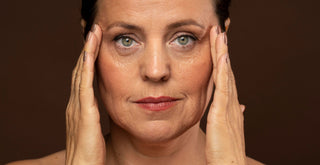Unlock the secrets behind aging skin as we delve into the science of collagen, elastin, and other essential components. Learn about their decline and how to support their production through a combination of skincare and lifestyle choices.
At a certain point, we all look in the mirror and begin to notice the telltale signs of time's passage on our skin.
Some of us scoff and roll our eyes, muttering something about "damn wrinkles," while others hastily rummage through myriad lotions, potions, and promise-holding bottles.
Regardless of how we react, the question remains: What's behind these visible signs of aging?
Let's dig into the science of aging skin, specifically dissecting the roles of collagen, elastin, and other key players. [1]
Collagen and Elastin: The Unsung Heroes of Youthful Skin
When it comes to taut, youthful skin, two proteins play a leading role: collagen and elastin. [2]
To put it simply, collagen is the skin's scaffolding, providing strength and firmness. In contrast, elastin gives skin its elasticity and the ability to bounce back.
These proteins are like Batman and Robin of the skin world, each is impressive on its own, but together they're the perfect team.
Sadly, with age, the production of these super protein’s declines. The reason? A villainous trio: time, environmental factors and, according to recent studies, a drop in the levels of a coenzyme called NAD+ [3]
The Mysterious Role of NAD+ in Skin Aging
You might be scratching your head wondering, "What in the world is NAD+?"
It's a molecule that's vital for energy production in all body cells, including those responsible for producing collagen and elastin.
Alas, as we age, our NAD+ levels start to sink, potentially contributing to the slow-down in production of these skin-preserving proteins
Top Factors Slowing Down Your Collagen and Elastin Production
- Sun exposure: UV rays from the sun can break down collagen and elastin fiber's, speeding up skin aging.
- Smoking: Toxins from smoking impair collagen production and accelerate the aging process.
- Poor nutrition: A diet lacking in essential nutrients can limit your skin's ability to produce collagen and elastin.
Boosting Collagen, Elastin, and NAD+ Levels: A Holistic Approach
So, how can we combat these bad boys of aging and maintain our youthful-looking skin?
It's a matter of combining skincare and lifestyle choices:
- Invest in a good sunscreen to protect your skin against harmful UV rays.
- Quit smoking, if you're a smoker. This single act can help prevent premature skin aging.
- Eat a nutrient-rich diet to provide your skin with the needed elements for collagen and elastin production.
What's more, studies are hinting at the effectiveness of oral and topical NAD+ boosters for skin health, although more research is needed to confirm this direction. [4]
FAQs
1. Why does skin age?
Skin ages because of a combination of natural aging, exposure to environmental factors, and a decrease in collagen and elastin production.
2. Can we prevent skin aging?
While we cannot entirely prevent skin aging, we can slow down the process by protecting our skin from the sun, steering clear of smoking, and maintaining a balanced diet.
3. What is the role of NAD+ in skin health?
NAD+ is important for energy production in cells. Low levels of this molecule may contribute to decreases in collagen and elastin production, thereby playing a role in skin aging.
Conclusion
There's no magic wand to wave away the science of aging skin. But understanding the important roles played by collagen, elastin, and potentially NAD+ helps chart a course towards smarter skincare and lifestyle choices.
As it turns out, taking the time to grasp the way our skin changes give us the real strength to face whatever time's course will trace on our appearance.
After all, beauty may indeed be skin deep, but wisdom goes right down to the bone.
References:
[1] López-Otín, C., Blasco, M. A., Partridge, L., Serrano, M., & Kroemer, G. (2013). The Hallmarks of Aging. Cell, 153(6), 1194–1217.
[2] Shoulders, M. D., & Raines, R. T. (2009). Collagen Structure and Stability. Annual Review of Biochemistry, 78(1), 929–958.
[3] Morita, A. (2007). Tobacco Smoke Causes Premature Skin Aging. Journal of Dermatological Science, 48(3), 169–175.
[4] Elaine L Jacobson (2007). A topical lipophilic niacin derivative increases NAD, epidermal differentiation and barrier function in photodamaged skin. Experimental Dermatology.

